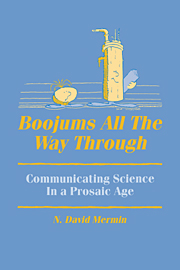Book contents
- Frontmatter
- Contents
- Preface
- I Reflections on the pursuit of physics
- 1 E pluribus boojum: The physicist as neologist
- 2 Commencement address, St. Johns College, Santa Fe, May 18, 1986
- 3 “One of the great physicists … and great characters”
- 4 My life with Landau
- 5 What's wrong with this Lagrangean?
- 6 What's wrong with this library?
- 7 What's wrong with this prose?
- 8 What's wrong with these equations?
- 9 What's wrong with these prizes?
- II The quantum theory
- III Relativity
- IV Mathematical musings
8 - What's wrong with these equations?
Published online by Cambridge University Press: 02 December 2009
- Frontmatter
- Contents
- Preface
- I Reflections on the pursuit of physics
- 1 E pluribus boojum: The physicist as neologist
- 2 Commencement address, St. Johns College, Santa Fe, May 18, 1986
- 3 “One of the great physicists … and great characters”
- 4 My life with Landau
- 5 What's wrong with this Lagrangean?
- 6 What's wrong with this library?
- 7 What's wrong with this prose?
- 8 What's wrong with these equations?
- 9 What's wrong with these prizes?
- II The quantum theory
- III Relativity
- IV Mathematical musings
Summary
A major impediment to writing physics gracefully comes from the need to embed in the prose many large pieces of raw mathematics. Nothing in freshman composition courses prepares us for the literary problems raised by the use of displayed equations. Our knowledge is acquired implicitly by reading textbooks and articles most of whose authors have also given the problem no thought. When I was a graduate teaching assistant in a physics course for non-scientists, I was struck by the exceptional clumsiness with which extremely literate students, who lacked even the exposure to such dubious examples, treated mathematics in their term papers. The equations stood out like dog turds upon a well manicured lawn. They were invariably introduced by the word “equation” as in “Pondering the problem of motion, Newton came to the realization that the key lay in the equation
To these innocents equations were objects, gingerly to be pointed at or poked, not inseparably integrated into the surrounding prose.
Clearly people are not born knowing how to write mathematics. The implicit tradition that has taught us what we do know contains both good strands and bad. One of my defects of character being a preference for form over substance, I have worried about this over the years, collecting principles that ought to govern the marriage of equations to readable prose. I present a few of them here, emphasizing that the list makes no claim to be complete.
- Type
- Chapter
- Information
- Boojums All the Way throughCommunicating Science in a Prosaic Age, pp. 68 - 73Publisher: Cambridge University PressPrint publication year: 1990

